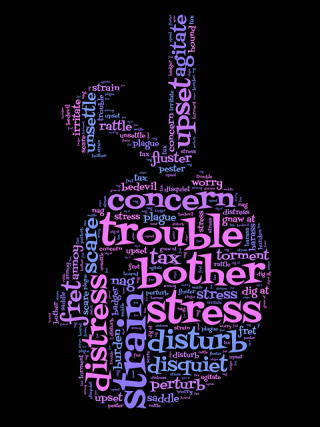Stress
Detoxing After Detox: The Perils of Post-Acute Withdrawal
If you think detoxing from alcohol and other drugs ends withdrawal, think again.
Posted May 26, 2015 Reviewed by Abigail Fagan

Quitting smoking is easy, I’ve done it thousands of times. —Mark Twain
A common misconception shared by many people, including those with addiction, their loved ones and friends, and even some medical and behavioral health professionals, is that soon after the offending substances are out of the body (upon completion of detoxification or acute withdrawal), life will get noticeably better and “normal” functioning will return. If only that were true.
There are actually two phases of the withdrawal process. After detox/acute withdrawal is over, the second phase of the withdrawal process kicks in. Depending on the length and intensity of active addiction—that is, how frequently, how much, and for how long an individual has used mind- and mood-altering substances—this second phase can last for weeks or even months after someone has stopped using. This exquisite phenomenon is known as post-acute withdrawal (sometimes referred to as protracted withdrawal). Post-acute withdrawal (PAW) is a constellation of often brutally uncomfortable symptoms that persist even after all physical traces of alcohol and drugs have left the body and brain.
These symptoms affect many people in the early phases of abstinence from numerous substances, but they occur in an extremely high percentage of those with histories of long-term opioid use. This is among the reasons why people with chronic pain who have been treated with opioid painkillers frequently have great difficulty getting off those medications.
Post-acute withdrawal varies in intensity and duration from one person to another; again, usually in correlation with the intensity and duration of one’s substance use. Its manifestations can fluctuate in severity, coming and going in wave-like recurrences, and include impairments in energy, concentration, attention span, memory, sleep, appetite, and mood—most commonly anxiety, irritability, anger, and depression.
As challenging as it is, post-acute withdrawal is a necessary process that everyone in early recovery must go through, as the brain and body begin to heal and reorient to life without the use of alcohol or other drugs.
Post-acute withdrawal is a consequence of the significant changes to brain anatomy and chemistry that take place during active addiction. The brain’s reward system is turned on its head, and its natural ability to cope with stress is undermined. For those who use opiates or opioids—from medically prescribed pain medications to heroin—the brain adjusts by decreasing its natural production of endorphins while increasing the number of opioid receptors. This increases sensitivity to pain and makes it much harder to experience pleasure in the absence of using.
In early abstinence, the brain’s stores of endorphins and dopamine are severely depleted. Dopamine, the neurotransmitter that floods the brain during drug use to produce titanic highs, is also involved in the regulation of mood, and a certain amount is necessary in order to maintain a “normal” mood. The absence of enough dopamine creates a biochemically based depression. It can take between four weeks and six months for the brain to naturally manufacture enough endorphins and dopamine to replenish its inventory of these vital chemicals.
The human nervous system consists of two main parts, the central nervous system (CNS) and the peripheral nervous system (PNS). The CNS contains the brain and spinal cord. The PNS consists mainly of nerves that connect the CNS to the rest of the body so that information can be sent back and forth between them. The autonomic nervous system (ANS) is part of the peripheral nervous system. The ANS acts as a control mechanism for most internal organs and ordinarily functions below the level of conscious awareness.
Active addiction precipitates a massive increase in the activity of the sympathetic division of the autonomic nervous system. The sympathetic division of the ANS is activated under circumstances of perceived threat and sets in motion the chain of survival-focused physiological responses that prepare the body for “fight or flight” (or to freeze). These unconscious responses occur automatically, putting mind and body on high alert, readying for action by initiating hypervigilance, increasing heart rate, constricting blood vessels, increasing blood pressure, dilating pupils, and inhibiting digestion.
While the fight, flight, or freeze mode kicks into gear in response to the stress of potential threats, the nature of these physiological reactions themselves creates additional stress that becomes chronic in active addiction. It’s as if the stress switch is stuck in the “on” position. This taxes many of the body’s systems, leading to a wide-awake form of exhaustion, a run-down immune system, greater vulnerability to illness, and yes, more stress.
This chronic stress response continues during post-acute withdrawal, receding and effectively resetting only gradually over time. As a result, people come into recovery under the influence of biologically birthed higher levels of stress in combination with enhanced susceptibility to stress. Meanwhile, early recovery can be incredibly stressful in and of itself. All sorts of stressful situations inevitably arise, and the frustration, confusion, and blistering discomfort of post-acute withdrawal symptoms (stress-inducing in and of themselves) piggyback onto them to produce even more distress.
Even when people have a genuine desire to stay clean, post-acute withdrawal is a driving factor in many relapses. This notwithstanding, PAW is often under-recognized and its impacts under-appreciated. Both addicts and their significant others are commonly encouraged to believe that after the drugs are gone, life will begin to improve rapidly. When reality fails to fulfill this unrealistic expectation, the disappointment and upset can be profound. Common reactions for those experiencing post-acute withdrawal include:
- "I can’t stand this!"
- "This is too uncomfortable. I don’t want to deal with it!"
- "If being clean feels this badly, I might as well use."
This thought process is normal for those in early recovery. Even though it can feel as though it will last forever, it’s important to know that post-acute withdrawal is always temporary. Getting through it requires being able to tolerate distress, aided by the awareness that it will get better. As difficult as PAW symptoms can be, they eventually subside.
Early recovery can be a minefield. When people are equipped with the conscious awareness of what the obstacles are and where they are located, many are able to find their way through them successfully. Fortunately, feeling comfortable is not a prerequisite for recovery.
Copyright 2015 Dan Mager, MSW
Dan Mager is the author of Some Assembly Required: A Balanced Approach to Recovery from Addiction and Chronic Pain.




